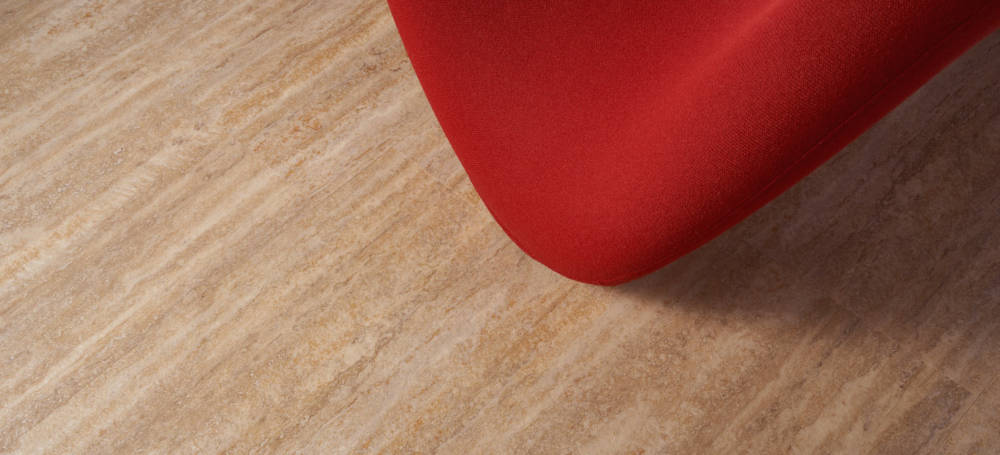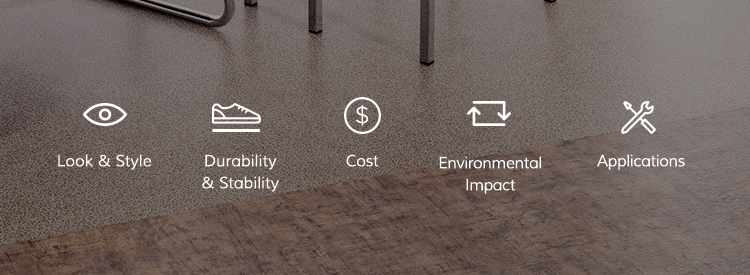Vinyl Tile vs. Ceramic Tile: Cutting Edge Beauty is Not Set in Stone

No Competition Between Luxury Vinyl Flooring and Ceramic
As the technology behind luxury vinyl flooring develops, it becomes less and less distinguishable from the real product (in this case, ceramic tile). LVT’s ability to mimic the appearance of the real thing has boosted the popularity of vinyl flooring that looks like ceramic tile. More often than not, luxury vinyl tile performs better than ceramic tile.
To best illustrate the comparable characteristics of luxury vinyl tile vs. ceramic tile, let’s look into five quantifiable qualities: Look & Style, Durability & Stability, Environmental Impact, Applications, and Cost.

Look & Style
Ceramic floors last forever. While that may sound like a selling point, as a style-conscious designer, you may see the flaw. Trends change quickly. However, if you have ceramic floors, changing with the trends just isn’t an option. Ceramic flooring is expensive, messy and time-consuming to install and remove. Conversely, luxury vinyl flooring is easy to install and replace tile-by-tile. And with a vast selection of looks and styles, vinyl flooring that looks like ceramic is the best solution.
Cutting ceramic tiles requires expensive tools and skills resulting in costly hours for professionals. Luxury vinyl flooring, on the other hand, can be cut easily with a straight edge and utility knife, and is not nearly as time-consuming to install. Any number of designs, including those that look like ceramic are possible with luxury vinyl.
Ceramic Tile
- Ceramic floors last forever, but fashion and design trends change quickly; ceramic flooring is expensive, messy and time-consuming to install and remove.
Luxury Vinyl Tile
- Vast selection of designs and styles, LVT is limitlessly customizable
- Luxury vinyl flooring is extremely easy to install and reinstall with changing trends.
Durability & Stability
Before discussing the durability and stability of luxury vinyl tile vs. ceramic tile, we should define the terms, as they seem similar.
Durability: Hardness of the flooring—especially its topmost wear layer. The more durable a flooring solution is, the more use it can take.
Stability: Governed by the thickness of the whole and/or makeup of layers and quality of materials. Stable flooring material holds its shape and size against moisture and/or climatic changes.
Yes, ceramic, if taken care of, will essentially last forever. However, in the all too common event that it is damaged—ceramic is quite a hassle to repair. Although ceramic is a hard, durable material, many circumstances can cause significant damage. If tiles are not installed correctly (i.e. improperly set mortar or incorrect grouting) the grouting will fail and the tiles will separate, come loose and crack.
Ceramic’s strongest characteristic in this section is in its stability. Moisture and environmental changes will not affect the flooring. It will not expand or contract. However, the stability of ceramic is also its downfall. Because there is no flex or give in ceramic flooring, it is far more prone to cracks and other damages than luxury vinyl flooring. While LVT is extremely hard and durable—well suited for heavy commercial use—it has a degree of flex. This flex allows it to absorb and dissipate the force from some dropped heavy objects. Why take the risk of broken tiles when you can install vinyl flooring that looks like ceramic?
Ceramic Tile
- Ceramic’s strongest characteristic is its stability.
- No flex or give in ceramic flooring, far more prone to cracks and other damage.
Luxury Vinyl Tile
- LVT has an extremely durable wear layer and is less prone to cracking and breaking.
- Has a degree of cushioning that absorbs and dissipates the force from heavy objects.
Environmental Impact
The impact of luxury vinyl tile vs. ceramic tile comes down to their lifecycles. The argument is simple. Because of the method used to remove ceramic tiles (smashing into pieces) this type of flooring is not recyclable. To reuse the ceramic, every speck of mortar would need to be removed—a process not worth anyone’s time. And even then, you are left with broken bits good only for fill. So ceramic is usually just thrown into a landfill. In addition, the removal of ceramic tile directly impacts the environment of the area in which it was laid. Thick clouds of toxic dust are harmful to breathe in and nearly impossible to prevent.
Luxury vinyl tiles are typically recyclable and can be made from recycled material. In addition, luxury vinyl made by Parterre uses one of the most abundant materials on earth as the main ingredient: salt. In using salt, Parterre reduces ecological impact.
Ceramic Tile
- Ceramic is not recyclable, it is usually put in a landfill.
Luxury Vinyl Tile
- Parterre LVT is comprised of an abundant material, salt.
Applications
In the event that a ceramic tile becomes compromised, action must be taken right away. Jagged edges threaten trips or cuts, and allow moisture and other foreign material to move under and between tiles. But the cons to ceramic application do not end here.
Anyone who has ever installed or removed ceramic knows how messy it can be. No amount of plastic, fans or precautions will stop the dust from penetrating a work zone. The removal and installation take days, but the cleanup can take weeks. Even minor, one or two tile replacements require large hammers, chisels or power tools and the complicated mixing of and setting mortar and grout.
Luxury vinyl tile is just the opposite. Installing LVT is a simple process; your professional installers will have no trouble quickly and efficiently installing the flooring. Removing vinyl flooring is an even easier process.
As for the functional applications for both, there is little competition. Whether in a high-traffic commercial setting or high moisture area like a restaurant or supermarket, luxury vinyl tile performs well. Vinyl that looks like ceramic is more comfortable to walk on, unlike ceramic. Ease of installation, removal, repair, easy cleaning, more reliable durability, and a wider range of looks and design options make LVT a no-brainer.
Ceramic Tile
- Ceramic is limited by its installation, removal, customization costs and time.
Luxury Vinyl Tile
- Ease of installation, removal and repair.
- More reliable durability and a wider range of looks and design options.
Cost
The prices of luxury vinyl tile flooring vs. ceramic tile are comparable at some levels and quite unequal at others. Depending on the size, color and quality of the tiles, ceramic falls within and far above the price of LVT.
With such high prices, you could say designers are buying ceramic for the high-end look and longevity. However, with the photographic technology and durable wear layer texture printing available to luxury vinyl tile makers, luxury vinyl that looks like ceramic is nearly indistinguishable from the real thing and can withstand extended use.
Ceramic Tile
- Depending on the size, color and quality of the tiles, ceramic falls within and far above the price of LVT.
Luxury Vinyl Tile
- LVT is not only less expensive than ceramic, it offers a much higher value.
If you found this comparison of luxury vinyl tile vs. ceramic tile flooring helpful, you can find more information on our blog. At Parterre, we are the leaders in modern, high-quality premium vinyl flooring. We want to inspire you and provide the perfect flooring for your next project.
Parterre Flooring
Read MorePolished Concrete vs. Vinyl Flooring
Polished Concrete vs. Vinyl Flooring Polished concrete vs. vinyl flooring. It’s not an easy decision, considering both provide an excellent solution for commercial flooring. The look of concrete floors has been a growing trend for commercial interiors.
Chevron and Herringbone
Break the Pattern of Commercial Flooring You can add more flair to your commercial flooring by breaking from the look of traditional straight-line, square, and diagonal patterns. Eye-catching looks like chevron and herringbone will dot the designer landscape in 2024.